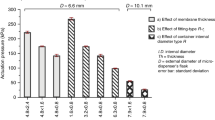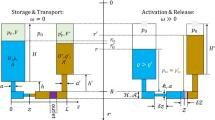Abstract
We present the analysis of blister pouches for reagent storage and release into microfluidic devices towards point-of-care blood cell counting applications. Blister pouches provide an effective reagent storage mechanism and can be mounted onto microfluidic cartridges directly. Reagents can be released from blister pouches through automated or manual compression and consequent rupturing of the pouches. A microfluidic device for metering of blister pouch contents was developed and investigated as part of this work, as precise volumes of reagents are often required when performing reactions, and particularly for blood cell counting applications which are the focus of this study. The metering device shows high accuracy and repeatability with an error of 1.93% and standard deviation of 3.1% across 30 test results. This work also investigates important blister pouch characteristics for three different types of blister pouch foil materials, including forces required to burst the blister, as well as shelf life and reagent compatibility of the blisters. Typical forces required are in the range of 25–35 N depending on the blister foil material used. Blister shelf life can be greatly affected by the reagent being stored, and thus, the blister foil material choice is crucial. This work provides a clear understanding of the implementation required to ensure that the blister pouches can be effectively used on microfluidic chips, with an example application area being point-of-care diagnostics.















Similar content being viewed by others
References
Abbott Laboratories (2015) i-Stat® Test Cartridges, Abbott Point of Care, viewed 20 April 2016. https://www.abbottpointofcare.com/products-services/istat-test-cartridges
Bau HH, Liu C, Qiu X (2010) Biodetection cassette with automated actuator. US Patent US20100035349 A1
Becker H (2009) Hype, hope and hubris: the quest for the killer application in microfluidics. Lab Chip 9:2119–2122. doi:10.1039/B911553F
Becker H, Gärtner C (2008) Polymer microfabrication technologies for microfluidic systems. Anal Bioanal Chem 390(1):89–111
Bozhi Y, Levis JW, Qiao L (2004) A PDMS-based constant-flowrate microfluidic control device. In: Proceedings of 17th IEEE international conference on micro electro mechanical systems (MEMS), pp 379–382
Chen D, Bau HH, Mauk MG, Qiu X, Kwa J (2010a) Mechanically actuated diagnostic device. US Patent US20100304986 A1
Chen D, Mauk M, Qiu X, Liu C, Kim J, Ramprasad S, Ongagna S, Abrams WR, Malamud D, Corstjens PL, Bau HH (2010b) An integrated, self-contained microfluidic cassette for isolation, amplification, and detection of nucleic acids. Biomed Microdevices 12(4):705–719
Chin CD, Linder V, Sia SK (2007) Lab-on-a-chip devices for global health: past studies and future opportunities. Lab Chip 7:41–57
Chin CD, Linder V, Sia SK (2012) Commercialization of microfluidic point-of-care diagnostic devices. Lab Chip 12:2118–2134
Czurratis D, Beyl Y, Grimm A, Brettschneider T, Zinober S, Laermer F, Zengerle R (2015) Liquids on-chip: direct storage and release employing micro-perforated vapor barrier films. Lab Chip 15:2887–2895
Daktari Diagnostics (2015) viewed on 20 April 2016. http://daktaridx.com/
Findlay JB, Atwood SM, Bergmeyer L, Chemelli J, Christy K, Cummins T, Donish W, Ekeze T, Falvo J, Patterson D (1993) Automated closed-vessel system for in vitro diagnostics based on polymerase chain reaction. Clin Chem 39(9):1927–1933
Focke M, Kosse D, Muller C, Reinecke H, Zengerle T, von Stetten F (2010) Lab on a foil: microfluidcs on thin and flexible films. Lab Chip 10:1365–1386. doi:10.1039/c001195a
Giselbrecht S, Gietzelt T, Gottwald E, Guber AE, Trautmann C, Truckenmüller R, Weibezahn KF (2004) Microthermoforming as a novel technique for manufacturing scaffolds in tissue engineering (CellChips). IEE Proc Nanobiotechnol 151(4):151–157
Gomez FA (2013) The future of microfluidic point-of-care diagnostic devices. Bioanalysis 5:1–3
Hitzbleck M, Delamarche E (2013) Reagents in microfluidics: an “in” and “out” challenge. Chem Soc Rev 42:8494–8516
Hugo S, Land K, Becker H (2013) Characterization of microfluidic components for low-cost point-of-care devices. In: Proceedings of 17th international conference on miniaturized systems for chemistry and life sciences, pp 461–463
Inamdar T, Anthony BW (2013) Characterizing fluidic seals for on-board reagent delivery. In: Proceedings of SPIE 8615 microfluidics BioMEMS and medical microsystems XI, p 861516. doi:10.1117/12.2006257
Jangam SR, Agarwal AK, Sur K, Kelso DM (2013) A point-of-care PCR test for HIV-1 detection in resource-limited settings. Biosens Bioelectron 42:69–75
Jokerst JV, Floriano PN, Christodoulides N, Simmons GW, McDevitt JT (2008) Integration of semiconductor quantum dots into nano-bio-chip systems for enumeration of CD4+ T cell counts at the point-of-need. Lab Chip 8(12):2079–2090
Jokerst JV, Jacobson JW, Bhagwandin BD, Floriano PN, Christodoulides N, McDevitt JT (2010) Programmable nano-bio-chip sensors: analytical meets clinical. Anal Chem 82(5):1571–1579
Jung W, Han J, Choi JW, Ahn CH (2015) Point-of-care testing (POCT) diagnostic systems using microfluidic lab-on-a-chip technologies. Microelectron Eng 132:46–57
Kelso DM, Agarwal AK, Sur K, Beebe DJ (2012) Burstable liquid packaging and uses thereof. US Patent US2012010781 A1
Kim J, Johnson M, Hill P, Gale BK (2009) Microfluidic sample preparation: cell lysis and nucleic acid purification. Integr Biol 1:574–586
Lauks IR, Wieck HJ, Zelin MP, Blyskal P (1988) Disposable sensing device for real time fluid analysis. US Patent US5096669 A
Lewis SM, Bain BJ, Bates I (2006) Dacie and Lewis practical haematology. Churchill Livingstone, Philadelphia
McDevitt J, Haque A, McRae M, Simmons G (2015) Integrated instrumentation for the analysis of biofluids at the point-of-care. US Patent US20150004717 A1
Osei-Bimpong A, Jury C, McLean R, Lewis SM (2009) Point-of-care method for total white cell count: an evaluation of the HemoCue WBC device. Int J Lab Hematol 31(6):657–664
Pilchik R (2000) Pharmaceutical blister packaging, Part I. Rationale and materials. Pharm Technol 24(11):68–78
Qiu X, Thompson JA, Chen Z, Liu C, Chen D, Ramprasad S, Mauk MG, Ongagna S, Barber C, Abrams WR, Malamud D (2009) Finger-actuated, self-contained immunoassay cassettes. Biomed Microdevices 11(6):1175–1186
Qiu X, Liu C, Mauk MG, Hart RW, Chen D, Qiu J, Kientz T, Fiene J, Bau HH (2011) A portable analyzer for pouch-actuated, immunoassay cassettes. Sens Actuators B Chem 160(1):1529–1535
Selvakumar S, Linares R, Oppenheimer A, Anthony B (2012) Variation analysis of flow rate delivered using a blister pump. In: Proceedings of SPIE 8251 microfluidics BioMEMS and medical microsystems X, p 82510I
Sia SK, Kricka LJ (2008) Microfluidics and point-of-care testing. Lab Chip 8:1982–1983
Simmons GW, McRae MP, Shadfan B, Wong J, Christodoulides N, Ruijven PWMV, Hayes JP, Mehalso R, McDevitt JT (2014) Programmable bio-nano-chip system: an ultra-flexible platform for bioscience and clinical measurements. In: Proceedings of 18th international conference on miniaturized systems for chemistry and life sciences, pp 2059–2063
Smith S, Naidoo T, Davies E, Fourie L, Nxumalo Z, Swart H, Marais P, Land K, Roux P (2015) Sample to answer visualization pipeline for low-cost point-of-care blood cell counting. In: Proceedings of SPIE 9332 optical diagnostics and sensing XV: towards point-of-care diagnostics, p 93320V
Smith S, Sewart R, Land K, Roux P, Gärtner C, Becker H (2016) Blister technology for the storage of liquid reagents in microfluidic devices. In: Proceedings of SPIE 9705 microfluidics BioMEMS and medical microsystems XIV, p 97050F
Temiz Y, Lovchik RD, Kaigala GV, Delamarche E (2015) Lab-on-a-chip devices: how to close and plug the lab. Microelectron Eng 132:156–175
van Oordt T, Barb Y, Smetana J, Zengerle R, von Stetten F (2013) Miniature stick-packaging—an industrial technology for pre-storage and release of reagents in lab-on-a-chip systems. Lab Chip 13(15):2888–2892
Weaver W, Kittur H, Dhar M, Di Carlo D (2014) Research highlights: microfluidic point-of-care diagnostics. Lab Chip 14:1962–1965
Weber L (2015) Microfluidic storage device. US Patent US9211538 B2
Wright DW, Aiello D (2014) Apparatus, devices, and methods for manipulating deformable fluid vessels. US Patent US20140263437 A1
Yager P, Edwards T, Fu E, Helton K, Nelson K, Tam M, Weigl B (2006) Microfluidic diagnostic technologies for global public health. Nature 442:412–418
Yetisen AK, Volpatti LR (2014) Patent protection and licensing in microfluidics. Lab Chip 14:2217–2225
Acknowledgements
The authors gratefully acknowledge the Council for Scientific and Industrial Research (CSIR) in Pretoria, South Africa, for funding this project. Part of the work carried out at microfluidic ChipShop GmbH was financially supported by the European Union in an FP-7 Grant under the project “Routine”, Grant Agreement No. 304941, by the Bundesministerium für Bildung und Forschung (BMBF) through the Project “IMRA”, FKZ: 031A094C and the Project “MRCyte”, FZK 13N12018. The authors thank all project partners for their contributions.
Author information
Authors and Affiliations
Corresponding author
Ethics declarations
Conflict of interest
The authors declare that they have no conflict of interest.
Rights and permissions
About this article
Cite this article
Smith, S., Sewart, R., Becker, H. et al. Blister pouches for effective reagent storage on microfluidic chips for blood cell counting. Microfluid Nanofluid 20, 163 (2016). https://doi.org/10.1007/s10404-016-1830-2
Received:
Accepted:
Published:
DOI: https://doi.org/10.1007/s10404-016-1830-2




